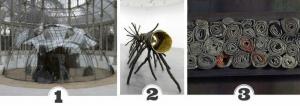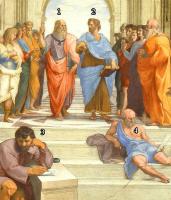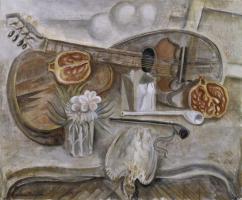Van Gogh's Sunflowers: Analysis and Meaning of the Arles and Paris Series
The sunflowers is the name by which seven Vincent van Gogh canvases are popularly known, which make up a series called The sunflowers of Arles, painted between 1888 and 1889. These canvases are the most popular works of the Post-Impressionist painter. In addition to this series, there is another known as Sunflowers of Paris, painted by Van Gogh a year earlier, in 1887.
The pictures of The sunflowers They belong to the genre of still life or still life, within which floral paintings stand out. Floral paintings were very common in the artistic tradition, especially in Holland, but they rarely included sunflowers, as they were considered coarse flowers. However, Van Gogh appreciated its simplicity, playfulness and wild appearance.
It is striking that such a simple motif represents one of the masterpieces of contemporary art. To what can we attribute this phenomenon? How can we understand Van Gogh's genius through his sunflowers? What are its characteristics and its significance?
The sunflowers of Arles

Vincent van Gogh refers to the project of The sunflowers of Arles like a "blue and yellow symphony." That is our first key to analysis: the artist intended to consolidate a harmonious set by taking advantage of the contrast between warm and cold tones. The technique chosen for the whole set was oil on canvas.
Each of the paintings contains simple and colorful shapes that, according to experts, evoke Van Gogh's taste for Japanese art. Of this japonism also came the technique known as cloisonism, widely used by Gauguin, whom Van Gogh admired so much. Cloisionismo consists of painting flat surfaces of color with silhouettes clearly delimited by thick lines.
The color yellow had a leading role in the series. In fact, in some of the paintings the painter demonstrates his expressive and persuasive ability by using just three shades of yellow, which was undoubtedly a genius at the time. The vibrant yellow hues used by the Dutch were made possible by industrial advancements in pigmentation in the late 19th century.

Now, what do we see on each canvas? Just sunflowers arranged in a vase. A curious fact is that these sunflowers are of two different varieties of the flower: we find sunflowers teddy bear or teddy bear and sunflowers big smile or smiling sunflower. Both are also varieties of dwarf sunflowers.
1. Vase with five sunflowers
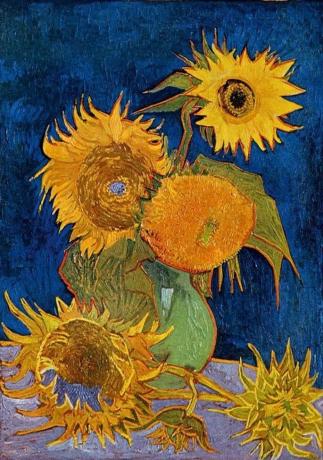
Vase with five sunflowers it was the first canvas in the Arles series. In this canvas we see three sunflowers standing in a vase and two withered sunflowers on the table. A discreet button sprouts from one of the fallen sunflowers. The background stands out with different shades of blue that remind us of the canvas The starry Night. Yellows evoke the vibrant luminosity of the canvas Arles coffee.
The vase is pale green in color and stands on an iridescent surface. The petals look like flames of the burning sun, while the core of the flowers differs from each other. Each flower is unique; none is repeated. While some appear full of life, others fade before our eyes.
2. Vase with fifteen sunflowers

On Vase with fourteen sunflowers, Van Gogh surprises with a revolution of warm tones. A palette of yellows, ocher and oranges are combined with inexpensive appearances of green, which barely marks the presence of the stems. It is an incandescent and luminous atmosphere. The fourteen sunflowers show different stages of flowering, as some are leafy and others have lost petals. We can distinguish the superposition of brush strokes, whose texture has not been concealed by the artist.
3. Vase with fifteen sunflowers
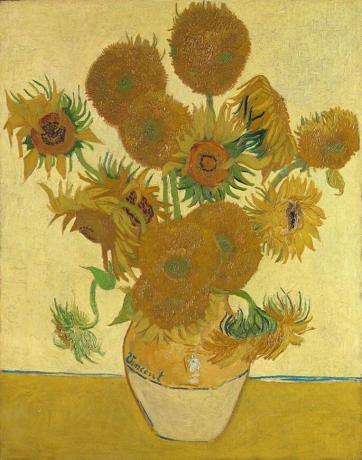
This is a version of the previous canvas (Vase with fourteen sunflowers) in which it introduces subtle differences. The surface that supports the vase is clearly separated from the background by a blue stripe. The same occurs in the vase, whose base stands out from the surface and, at the same time, marks its separation with the upper half of the vase, where we see Vincent's signature in a vivid blue.
This was one of the canvases destined for Paul Gauguin's bedroom. According to an article by Alastair Sooke, the thick blue lines that outline the vase and table could be understood as a tribute from Van Gogh to the painter. Sooke also maintains that as this was the first painting in the series to be signed, Van Gogh was aware of having achieved something significant.
4. Vase with fifteen sunflowers
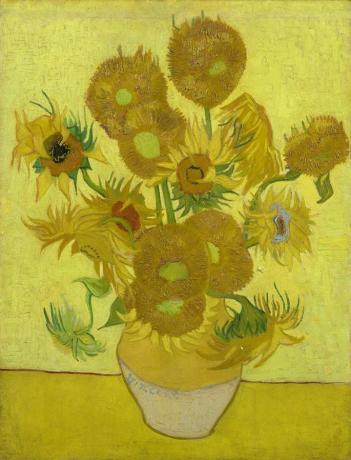
This piece is the second version that Va Gogh made on canvas Vase with fourteen sunflowers. The vibrant yellow of the petals stands out against the pale background. The center of the flowers becomes more striking. One of them stands out in the whole for its azure blue center that introduces visual vibration. The halves of the vase are separated by a blue line and, below this, we see Vincent's signature. The delimitation between the surface and the background is no longer blue but chestnut.
5. Vase with twelve sunflowers

Vase with twelve sunflowers shows a dialogue between yellow and turquoise blue, which marks its difference from the previous canvas. We see, in fact, brushstrokes of white applied directly to the canvas on the turquoise background. In general, the texture created by the thick brush strokes stands out. The boundaries are clearly outlined with earth tone lines.
In the dozen of flowers, ocher tones predominate and the center of some sunflowers combine intense earthy colors with small yellow particles that provide luminosity. This time, the vase has gained new life. It is no longer opaque and flat, but it is shiny and with a somewhat more defined volume than in the previous ones.
6. Vase with twelve sunflowers

In this version of Vase with twelve sunflowers, Van Gogh delivers a novel palette, enriched with different shades. Between yellow and pale blue, earthy colors, ocher and vibrant orange stand out. Contrast these colors with the inner one half of the vase, of an opaque purple hue. This contrasts with the luminosity of the upper half, turned on in light. The background, like the previous painting, is turquoise, which allows the yellow of the flowers to stand out.
7. Three sunflowers in a vase
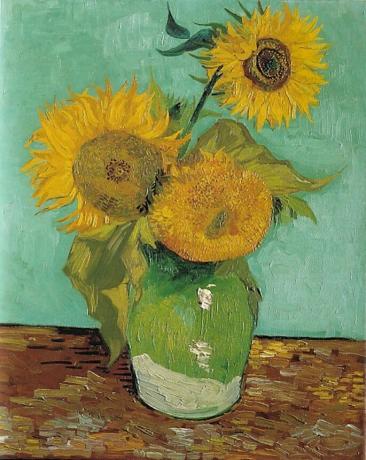
The Van Gogh Vase with Three Sunflowers canvas further explores the range of greens. The flowers, always in a bright and radiant yellow, explode against a aqua green background. They are supported by a vase that combines different shades of green and that achieves, through applications of white, to gain brightness and some volume.
We notice a major change on the surface. Although almost all the paintings in the series show the stroke of the brush, here the effect is less homogeneous. The contrast between brush strokes of different shades is more open, as the separation between them is more open. Blacks, yellows, chestnuts, ocher, greens and whites clearly overlap and distinguish one from the other. Nothing seems stable. The scene vibrates as a whole. Van Gogh has built a unique and personal language.
See also: The Starry Night by Vincent van Gogh
The sunflowers motif was present in Vincent van Gogh's work before developing the Arles (Provence) series. Sunflowers were part of the elements that decorated some of his scenes, until little by little they became a theme. But above all, before the Arles series, Van Gogh painted other less publicized canvases of sunflowers, known today as Sunflowers of Paris.
Sunflowers of Paris
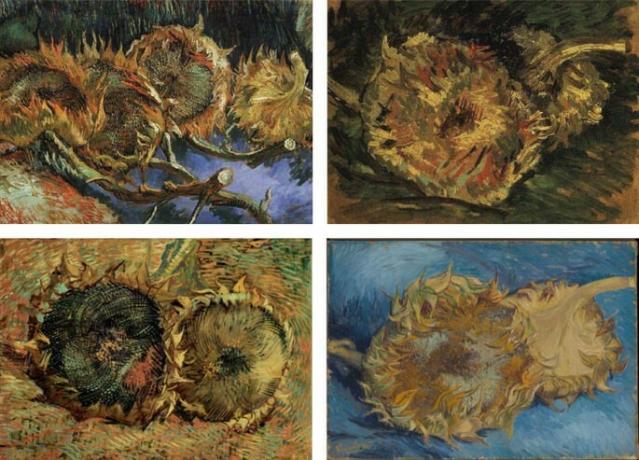
By 1887, Van Gogh was in Paris. The influence of Impressionism encouraged him to inquire into his own language, so he took sunflowers as an excuse to explore a new use of color.
Thus was born the first series of his sunflower paintings, which we know today as Sunflowers of Paris, immediate antecedent of the famous Arles sunflowers (Provence).
This group of still lifes is characterized by the representation of cut and withered sunflowers, turned into seeds. Sunflowers occupy the entire pictorial space and are represented in such a way that they approximate their natural size.
1. Four cut sunflowers
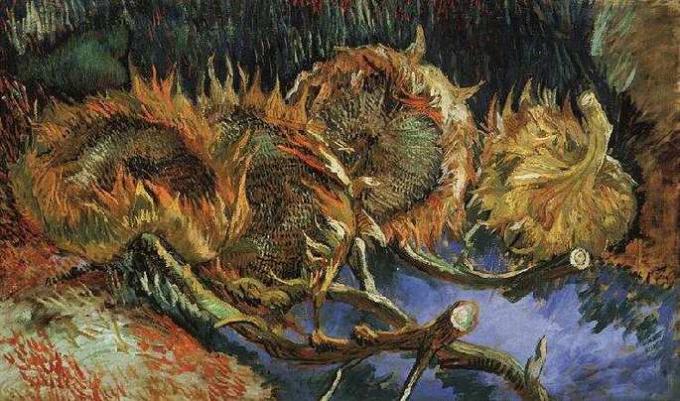
On canvas 1, Van Gogh depicts four cut and withered sunflowers. The way he uses coloring is impressive through the overlapping of hues on the canvas and the use of swirling line patterns in the center of the flowers.
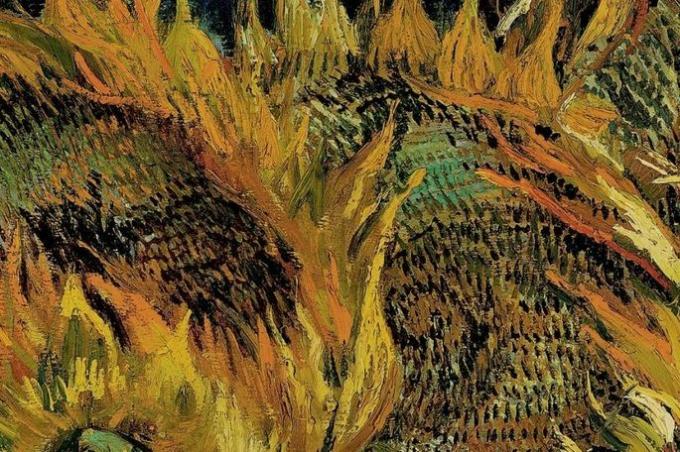
The background is complex: along the top line of the canvas, it is dark. Towards the sides it acquires more light and warmth, while in the center it seems to float on the blue.
2. Sunflowers turned into seeds
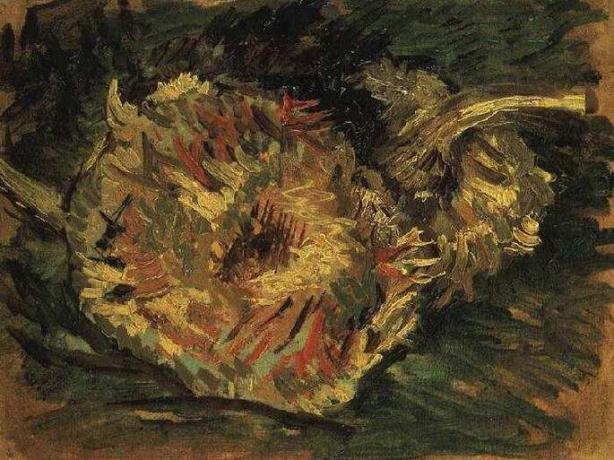
Two Cut Sunflowers stands out for the use of thick brush strokes to build texture and luminosity. Earth tones, green and yellow dominate. The canvas contrasts with the previous one due to its small size.
3. Two withered cut sunflowers

This canvas represents two sunflowers in which the almost mathematical patterns of their flower centers, that is, of their seeds, stand out in a particular way. A palette of yellow tones dominates that contrast with dark tones for the lines, as well as green and orange brushstrokes.
4. Two cut sunflowers

In this version of the cut sunflowers, the appearance of the blue background on which the flowers are framed stands out. In this way, it breaks with the earthy tones of the two previous canvases. The thick paint fillings in the brush strokes are particularly striking. It seems to be the announcement of the "blue and yellow symphony" that will be the Arles series one year later.
Meaning of The sunflowers by Van Gogh

Yes OK Sunflowers of Paris They were the first to be created, these canvases had a more experimental and plastic than expressive purpose. Is really in The sunflowers of Arles that Vincent van Gogh gets to be made owner of sunflowers.
On The sunflowers of Arles, yellow expresses joy and celebrates life touched by divine light. Remember that the sunflower flower receives that name because it is oriented in the direction of the sun. Due to this fact, added to their shape and color, sunflowers are solar symbols for Van Gogh. But what does this mean? Van Gogh associated the color yellow with the sun and with life, and also associated the sun with Christ, whom he considered the light of the world.
Let us also remember that when Van Gogh conceived the Arles series, he was enthusiastic about the visit of Paul Gauguin, who would join the Yellow House project. Thus, the enthusiastic heart of the Dutch vibrated with gratitude in The sunflowers of Arles, two of which were destined for Gauguin's room.
The mystery of life and time
We must highlight another aspect. On each of the canvases of The sunflowers of Arles, we see different flowering stages of sunflowers: button sunflowers, ripe sunflowers and withered or withered sunflowers.
As the English critic Alastair Sooke suggests, we could interpret the work as the expression of the passage of time and ages, a symbol of life and the vagaries of time. After all, this is one of the meanings attributed to the genre of the still life.
The hidden beauty
Vincent van Gogh wanted to be known expressly as the painter of sunflowers and, in fact, declared to his brother “the sunflowers are mine”. But why? At the beginning of his career, the painter dabbled in floral painting, which was a fairly developed genre in Holland. Certainly these works were selling well and Van Gogh wanted to enter the art market.
He began by painting some traditional floral pictures, but very soon he found himself experimenting with colors and techniques, but also with the motif: sunflowers. Almost no one painted sunflowers. The artists considered them crude. However, Van Gogh was able to see the hidden beauty in them.
Perhaps, we can see Van Gogh as one of those unique and particular sunflowers, see him in all his personal stages: Van Gogh being born and vibrating in the fullness of him, Van Gogh seeking the divine light, Van Gogh showing the hidden beauty of him, Van Gogh without roots shedding its leaves in a vase. Perhaps that is why, for Paul Gauguin, The sunflowers they were "completely Vincent."
It may interest you:
- Vincent van Gogh Paintings Explained
- Postimpressionism
History of The sunflowers by van Gogh
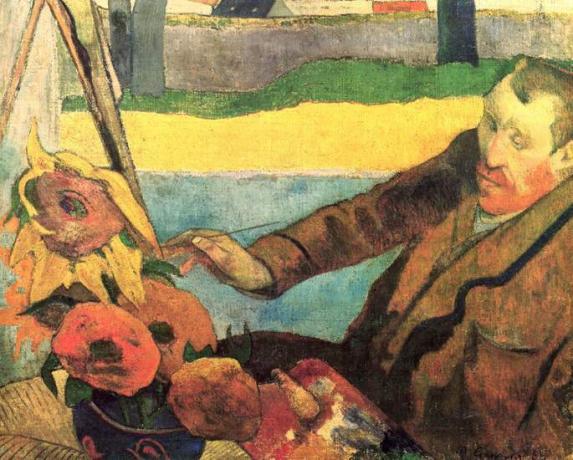
The Serie The sunflowers of Arles It was conceived as a project of twelve canvases destined to decorate the Yellow House in Arles, where Van Gogh lived. The artist wanted to turn the house into the residence of a movement of painters. His first (and only) resident was his friend Paul Gauguin, so two of those canvases were destined for his bedroom. In a letter addressed to his brother Theo, an art merchant, Van Gogh states:
In the hope of living in a workshop of ours with [Gauguin], I would like to make a decoration for the workshop. Nothing but big sunflowers... Anyway, if I execute this plan, I will reach a dozen frames. The whole will be a symphony in blue and yellowWell, I work all these mornings, since the sun rises, because the flowers wither immediately and it is a question of making the whole in one stroke... (Letter dated August 15, 1888)
Vincent van Gogh was very excited about Gauguin's visit and the idea of turning the Yellow House into an artist residence. Gauguin highly valued The sunflowers, and he perceived them as "completely Vincent." In fact, he wanted to acquire some of the canvases, but Vincent had some reluctance.
During his visit to the Yellow House, the friendship between the two soon turned sour. Gauguin made a portrait of the Dutch artist called Van Gogh painting sunflowers. Vincent felt violated and, from then on, the conflicts began. Gauguin decided to leave the Yellow House, but even so, Vincent's hostility did not cease, reaching the point of mutilating his ear.
The lost canvases of The sunflowers of Arles

Currently, two of the canvases in the series The sunflowers of Arles they are not available to the public. One of them was destroyed and the other was acquired by a private collector. For their part, two of the canvases that are still preserved were on the verge of disappearing in the first half of the 20th century. Let's find out what happened in each case mentioned.
Vase with five sunflowers. Calcined. The first canvas in the Arles series, called Vase with five sunflowers, was acquired by the Japanese collector Koyata Yamamoto, whose friendship with the writer and artist Saneatsu Mushanokoji piqued his interest in Van Gogh. After the purchase, the painting arrived in Japan on the Binna steamboat in 1920, and was successfully exhibited during 1921.
As its frame was very heavy, the work fell off the wall on display. Yamamoto decided not to display it again and tried to preserve the canvas in a safe vault in a bank. His request was rejected, since the bank did not want to be responsible for the damages that the humidity could cause. The collector had to keep the work in his house. Unfortunately, the canvas was burned during the bombing raids on the city of Ashiya in 1945, during World War II.
Vase with fourteen sunflowers. Collection of the National Gallery of London. This canvas was at risk of disappearing after the declaration of war in 1939, as the piece was in the custody of the Tate Gallery in Pimlico (Tate Britain), in London. Fortunately, he moved to Muncaster Castle in North West England. It was temporarily removed from the premises to restore it, a work carried out by the German exile, Helmut Ruhmann. Since the end of the war, in 1945, it was included in the collection of the National Gallery in London.
Twelve sunflowers in a vase. Collection of the Neue Pinakothek. Hitler considered Van Gogh's art (and contemporary art in general) to be degenerate, which almost caused this piece to disappear. The director of the Neue Pinakothek managed to hide the work in the warehouse, and evacuate it during the war to Neuschwanstein Castle. When the Nazis saw the lost war, they wanted to destroy the castle to prevent it from falling into the hands of the allies, but the subordinates refused. At the end of the war, the piece returned to the Neue Pinakothek.
Vase with three sunflowers. Private collection. During the first half of the 20th century, the piece Vase with three sunflowers It was acquired by a private collector in the United States. The work was exhibited for the last time in 1948. Since then, it has not been seen publicly again. His current whereabouts are unknown.
References
Alastair Sooke: Van Gogh’s Sunflowers: The unknown history, BBC, 21st January 2014. On-line. Retrieved May 3, 2021.
Charles, Victoria: Vincent Van Gogh: The Sunflower Painter, 2019, Parkstone International, Grand Masters Collection.
Montes de Oca, Alejandro: The crossing of the image in the gaze of van Gogh, Frames 23 • UAM-X • MEXICO • 2004 • PP. 55-77.
Van Gogh Museum: 5 things you need to know about Van Gogh's 'Sunflowers'. On-line. Accessed April 29, 2021.
Van Gogh, Vincent: Letters to Theo, 1998, Barcelona: Idea Books, S.A. Translation by: Francisco de Oraa.

